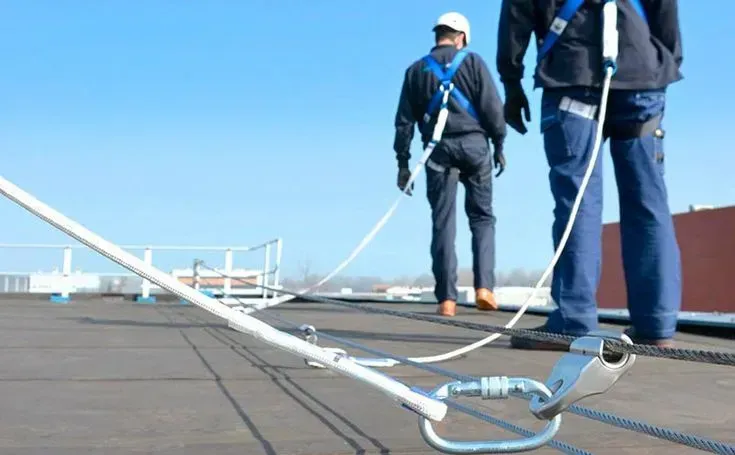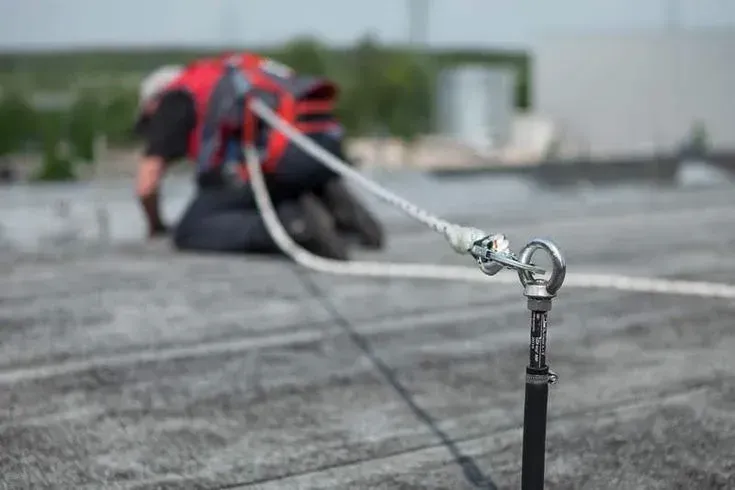
Flat Roofing for Rooftop Equipment Anchoring System Services by Chicago Elite Commercial Flat Roofing
Flat roofing for rooftop equipment anchoring systems is essential to maintaining the safety, stability, and longevity of commercial buildings in Chicago, IL. At Chicago Elite Commercial Flat Roofing, we specialize in delivering expert anchoring system installations designed specifically for flat roofs. Our focus is on providing secure, code-compliant solutions that keep your rooftop equipment firmly in place while protecting the integrity of your roofing system.
We recognize that rooftop equipment anchoring is not just about attaching hardware—it requires deep knowledge of roofing materials and strict adherence to local building codes. Our experienced team is proficient in working with all major flat roofing types, including TPO, EPDM, and PVC. This expertise allows us to customize anchoring systems that integrate flawlessly with your existing roof, ensuring no compromise on waterproofing or structural performance.
By choosing Chicago Elite Commercial Flat Roofing, you gain a trusted partner committed to installing rooftop anchors that withstand Chicago’s harsh weather conditions, from heavy snow loads to strong winds. Our installations reduce the risk of equipment movement or damage, which can lead to costly roof repairs or safety hazards. We prioritize durability and safety in every project, helping you avoid downtime and extend your roof’s service life.
Flat Roofing Solutions for Rooftop Equipment Anchorage
We prioritize the integrity of flat roofing systems when installing anchoring solutions for rooftop equipment. Proper selection of roofing types, material compatibility, and load-bearing capacity ensures safety and durability.
Types of Flat Roofs Suitable for Equipment Mounting
Flat roofs vary by construction and materials, influencing their suitability for rooftop equipment. Common types include built-up roofs (BURs), modified bitumen, and single-ply membranes such as TPO or EPDM.
Built-up roofs consist of multiple layers of bitumen and fabric, providing robust support for anchored equipment. Single-ply membranes, like TPO, offer durability and flexibility but require compatible anchoring methods to avoid membrane damage. Modified bitumen roofs combine BUR and single-ply features, balancing strength and adaptability.
We assess roof type carefully to ensure secure mounting points without compromising waterproofing or structural integrity.

Anchoring System Compatibility with Roofing Materials
Equipment anchoring systems must match the roofing material to prevent leaks and damage. Our approach includes selecting anchors designed for the specific membrane or roofing substrate.
For example, mechanical anchors are suitable for rigid surfaces but must be installed with waterproof flashings. Adhesive or ballasted anchors work best with single-ply membranes, minimizing penetrations.
We also use sealants, flashing kits, or rubber boots that integrate with the roofing material to maintain the water-tight seal. Ensuring compatibility reduces risk of roof failure over time.
Load-Bearing Considerations
Evaluating load-bearing capacity is essential for rooftop equipment installations. We analyze the roof deck structure, insulation, and existing loads before adding anchors.
The roof must support not only the weight of the equipment but also the dynamic forces caused by wind and maintenance activity. This involves load calculations and reinforcements if necessary.
We prioritize using lightweight anchor solutions where possible while ensuring compliance with safety standards to protect both the roof and personnel. Proper load management extends roof life and prevents structural damage.
Chicago Elite Commercial Flat Roofing Service Offerings
We provide precise solutions tailored to rooftop equipment anchoring, prioritizing structural integrity and safety. Our approach involves detailed evaluation and customized installation, along with ongoing maintenance to ensure performance and compliance.
Custom Anchorage System Installation
We design and install anchoring systems that are tailored specifically to the weight and type of rooftop equipment. Our process includes selecting materials compatible with the roofing surface and load requirements.
Each installation meets local building codes and relevant safety standards. We focus on minimizing roof membrane penetration to reduce leaks and maintain waterproofing integrity. Our team uses corrosion-resistant fasteners and reinforcement plates.
This custom approach extends the lifespan of both equipment and roofing, limiting movement during high winds or seismic activity. We adapt our designs for HVAC units, solar panels, and other mechanical systems.
Inspection and Assessment Protocols
Our inspections begin with a comprehensive survey of existing roof conditions and equipment mounting. We check for membrane damage, deterioration, and compliance with anchoring standards.
We employ visual and physical testing methods to identify weaknesses or potential hazards. Any signs of rust, loose fasteners, or shifting equipment are documented.
Our assessment reports include prioritized recommendations and cost estimates. We emphasize preventative measures to avoid costly repairs or system failures over time.
Maintenance and Repair Services
We offer scheduled maintenance to ensure anchoring systems remain secure and functional. This includes tightening fasteners, replacing worn components, and repairing membrane damage.
Our repair services address leaks, corrosion, and displacement issues promptly to prevent further deterioration. We adapt repairs to the specific roofing materials involved, maintaining system compatibility.
Regular maintenance supports safety compliance and extends equipment and roof service life. We tailor service frequency based on environmental exposure and equipment use patterns.
Safety, Compliance, and Long-Term Performance
We prioritize strict safety standards, regulatory compliance, and durability when installing rooftop equipment anchoring systems. Our approach ensures secure anchorage while protecting the roof structure from weather impacts and supporting equipment longevity.
Waterproofing and Weatherproofing Methods
Integrating anchors into flat roofs requires careful sealing to prevent water infiltration. We use compatible waterproof membranes and sealants tailored to Chicago’s climate challenges.
All penetrations are closely inspected and reinforced with durable flashing materials. These steps prevent leaks caused by rain, snow, or freeze-thaw cycles, preserving the roof’s lifespan.
We select weather-resistant materials tested for UV exposure and temperature variations. This protects not only the anchors but the roofing substrate from moisture damage and deterioration.

Adherence to Local Building Codes
We ensure all anchor installations follow Chicago’s specific building codes and OSHA regulations. This compliance reduces liability and meets safety requirements for workers performing rooftop tasks.
Our teams review codes related to load capacities, spacing, and materials. We coordinate with city inspectors when necessary to confirm installations pass mandatory inspections. This approach helps customers avoid costly fines and operational interruptions.
By aligning with local codes, we ensure that anchors provide reliable fall protection without compromising roof integrity or violating permit conditions.
Lifecycle Management for Rooftop Equipment
We design anchor systems for ease of inspection and maintenance over time. Regular check-ups detect loosening, corrosion, or wear early, enabling preventive repairs.
Our service plans may include scheduled maintenance reminders and on-call support for repairs or upgrades. This extends the overall lifecycle of both the anchoring system and rooftop equipment.
By maintaining these systems, we reduce risks of failure, increase safety margins for workers, and protect your investment in rooftop infrastructure.
Frequently Asked Questions
Securing rooftop equipment—like HVAC units, satellite dishes and exhaust fans—requires precision-engineered anchoring systems designed for Chicago’s unique weather and building codes. Our commercial flat roofing team specializes in installing, inspecting and maintaining anchoring solutions that protect your investment, ensure safety and meet all local regulations.
How do you ensure anchoring systems comply with Chicago building codes?
Our technicians stay current on Chicago’s Municipal Code and International Building Code updates. We submit engineered drawings for permit approval, use code-approved components and perform on-site inspections to guarantee full compliance.
What is the typical cost to install a rooftop equipment anchoring system on a commercial flat roof?
Costs vary by system type, roof size and equipment weight. On average, anchoring installations range from $25 to $40 per linear foot of equipment perimeter. We provide a detailed, line-item quote with no hidden fees.
How long does it take to install rooftop anchoring systems?
A standard rooftop equipment anchoring project—up to four units—can be completed in 1–2 days, weather permitting. Our Chicago team coordinates with your schedule to minimize operational disruptions.
Can you add anchors to an existing flat roof without voiding my roof warranty?
Yes. We use manufacturer-approved anchoring methods and work under your roof membrane’s warranty requirements. We’ll coordinate with your roofing manufacturer to maintain full warranty coverage.
Do you offer inspection and maintenance services for rooftop anchoring systems?
Absolutely. We recommend biannual inspections—spring and fall—to check for corrosion, ballast shifts and membrane damage. Our maintenance plans include tightening hardware, reballasting and membrane patching as needed.
